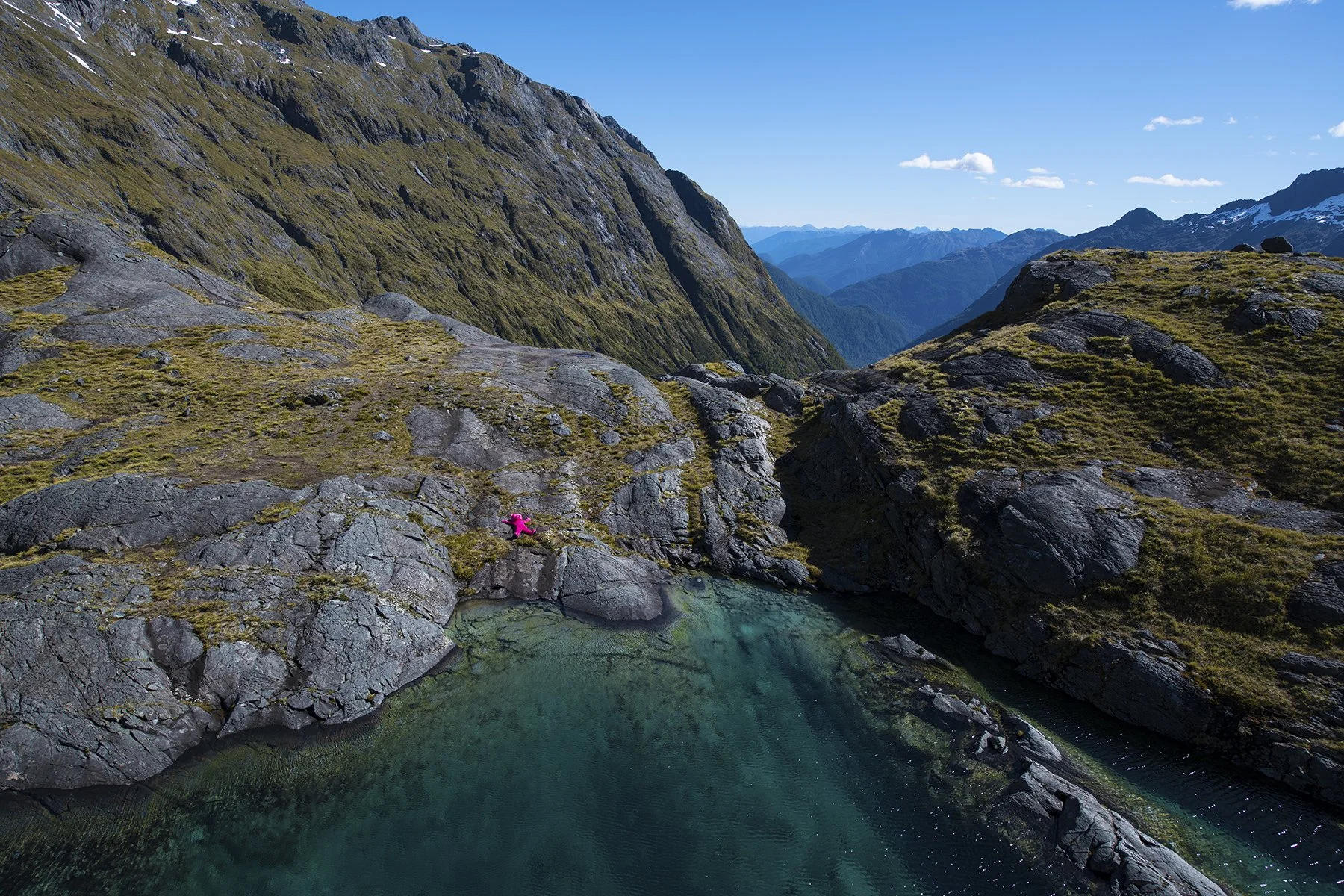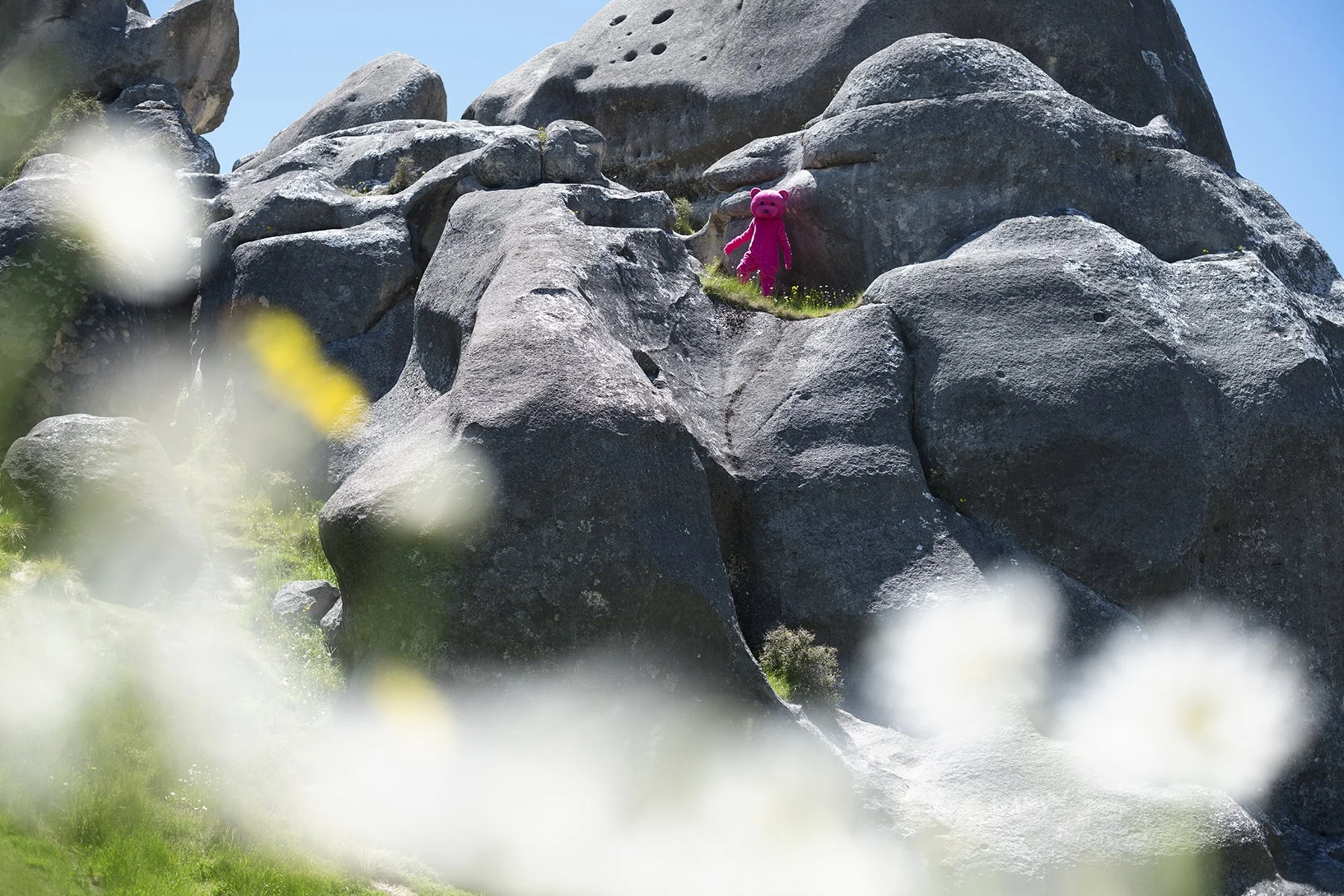A Southward Loop Through New Zealand, With The Pink Bear in the Passenger Seat
In late 2018, I travelled through New Zealand’s South Island in a rented camper van. It was spring, almost summer — lupin season, though I didn’t know that yet. I had no fixed plan. Just a map, a tank of fuel, and the Pink Bear strapped into the passenger seat beside me.
We began in Christchurch and, before heading inland, I took a detour to the sea. The water was cold, alive, wild with motion. I joined a small boat out past the surf, pulled on a wetsuit, and dropped into the swell. Within minutes, they came — dusky dolphins, curious and fast, circling like dancers that never stopped spinning. They cut through the waves like smoke. It felt like joy in motion, unfiltered and without agenda. The Bear waited back onshore, perched awkwardly on a driftwood stump, watching the ocean like it understood something I didn’t. That swim was the start of everything — a soft reset. An opening.
From there, I headed west across Arthur’s Pass, where the land begins to rise and twist and forget how to be straight. Rain swept over the mountains, and mist pressed low into the valleys. The van climbed slowly, tyres humming. On the far side, the coast arrived all at once — wild, unruly, indifferent.
We pulled off near Hokitika. A storm rolled in from the sea. The sky turned blunt grey and the wind blew sideways. I took the Bear down onto the beach — black sand, cold surf, driftwood curled like bones. I wrapped it in a plastic poncho, set up the tripod, and kept shooting until my hands ached. One frame caught it sitting on a log, legs splayed, staring out to sea like something exiled. I wasn’t sure what I was trying to capture. I never really am.
From there, we followed the coast south — Franz Josef, then Fox Glacier. The ice sat further away than the signs suggested. You had to squint to find it. At Lake Matheson we waited for the famous reflection, but the wind had other plans. The Bear posed anyway, mirrored loosely in the rippling water, like an echo trying to remember itself.
We turned inland, following the Haast River towards the Southern Alps. Somewhere near Makarora, I took a wrong turn. It cost eight hours, but I didn’t care. The road unravelled into silence. We passed a trout-shaped mailbox, a motionless horse in an open field, and long valleys where the sky stretched wider than it needed to. I can’t remember the names. Just the stillness.
Eventually we reached Fiordland. Milford Sound gave us everything — clear skies, still water, perfect light. We booked a helicopter. Just once. The pilot took us up and over the ridgelines, then dropped us beside a hidden lake, glacier-fed and lit like melted turquoise. The Bear lay back on the rock, arms wide, like it had been there the whole time. Everything around it was so quiet it felt suspended.
We passed through Queenstown quickly. Too curated. Too polished. The Bear didn’t belong there and neither did I. We moved on — into the hills beyond Glenorchy, where the land folds into itself and the lakes below look painted. There’s a photo from that day — the Bear high on a boulder, staring out like a tiny pink explorer. It still makes me smile.
We turned north again through Lindis Pass — all dry gold and long shadows — and dropped down into Tekapo. The lake was unreal. The kind of turquoise that doesn’t make sense until you’re floating in it. A friend of a friend had a boat. The Bear came waterskiing. Not well, but with full commitment. It cut across the surface like a ridiculous icon in motion — ears back, arms forward, pink fur flattened by speed. Completely out of place, and somehow exactly right.
That night, Tekapo turned quiet. We parked the van just outside the Dark Sky Reserve. I hadn’t planned it around the stars or the flowers, but both had shown up. The lupins were everywhere — waist-deep, purple, luminous. I waited for the Earth to turn. At three in the morning, I stepped out into the stillness. The Milky Way tore across the sky like it had been waiting. I lit the Bear with a head torch. It stood calmly in the middle of the flowers, glowing slightly in the dark. I didn’t move for a long time. The shutter clicked. The Bear held still. Everything just worked.
The next day we reached Aoraki Mount Cook. No hike. Just standing still at the edge of Lake Pukaki, watching the water shift and the mountain hold its line. The Bear climbed onto a rock and looked out. That was enough.
We drifted back through Wanaka, swam in a quiet bay, and dried clothes on the wing mirrors. The Bear lay face-up on a picnic bench, attracting stares but never questions. No one asked. They never do.
Later, we stopped at Castle Hill — giant limestone boulders scattered across a field like a broken sculpture. The Bear wandered through them slowly, sometimes hidden, sometimes framed perfectly between stones. It belonged in the shot without needing to justify itself.
And then, just like that, we returned to Christchurch. The loop was complete. The van was dusty. The cards were full. And the Bear had been in every frame it needed to be.
This wasn’t a holiday. It wasn’t a break. It was part of the work.
The Pink Bear is not a mascot. It is a presence — deliberately placed into real, wild places. Not for contrast. Not for attention. But to shift the way we see. To challenge how something surreal can exist without explanation. And be accepted.
That’s what this journey gave me. Not answers, but space. Not conclusions, but clarity. The Bear belonged here — because I made space for it to belong.
It made sense. All of it. And it still does.





